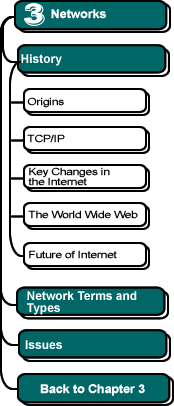

|
The World Wide Web
Back in 1945, Vannevar Bush, a member of U.S. President Franklin D. Roosevelt's administration, wrote a now-famous article entitled "As We May Think." Bush was frustrated by the inability of traditional library systems to keep up with the enormous increase in both printed documents and such new media as recordings and movies. Moreover, Bush observed that traditional cataloging schemes also enforced very limiting mental concepts of how items of information relate to other each other. Bush called upon the scientific community that had fought WWII to direct its energies toward more humane tasks. Specifically, Bush believed that a machine he called the Memex could be built that would be able to store information from a variety of media and would also be able to link these items to each other in every way imaginable. Thus, a Memex user would find information not by following the rigid rules of a cataloging system, but rather by following links corresponding to the kind of free associations that the human mind makes.
Bush's text was stunningly prescient: in many ways, he described the World Wide Web nearly 50 years before it came into existence.
In 1991, Tim Berners-Lee of the European Organization for Nuclear Research (CERN) developed and made public the World Wide Web (WWW), making the transfer of files over the Internet much simpler than was previously possible. The World Wide Web realized Bush's dream of what would come to be known as hypertext—text containing hyperlinks to other documents and media.
 Still,
the World Wide Web did not explode onto the scene until 1993,
when students at the University of Illinois Champaign-Urbana developed
Mosaic, a freeware graphical user interface (GUI) browser for the
Web. One of these University of Illinois students was Marc Andreesen,
who later joined with Jim Clark to develop Netscape,
an even more popular and powerful Web browser.
Still,
the World Wide Web did not explode onto the scene until 1993,
when students at the University of Illinois Champaign-Urbana developed
Mosaic, a freeware graphical user interface (GUI) browser for the
Web. One of these University of Illinois students was Marc Andreesen,
who later joined with Jim Clark to develop Netscape,
an even more popular and powerful Web browser.
Within a year, WWW-related traffic had surpassed e-mail traffic on the Internet. And an unprecedented increase in Internet use resulted:
- 1992: over 1 million hosts.
- 1993-94: emergence of the World Wide Web
- 1994: over 4 million hosts.
- 1994: NSF upgrades NSFNet backbone to 145 million bits (megabits) per second.
- 1995: 6 million hosts.
![]()
![]()
This chapter was written by Jeff Nyhoff and Joel Adams. Copy editing by
Nancy Zylstra
©2005 Calvin University (formerly Calvin College), All Rights Reserved
If you encounter technical errors, contact computing@calvin.edu.